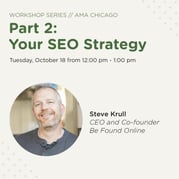
Migrating your website for a new launch can be a time-consuming task to undertake. To keep the process efficient and stress-free, we’ve outlined a few common questions along with our suggestions below.
Q: Do you recommend using a new URL when making a site transition?
A: If you’re going to change URLs, a site transition is often the best time to do it. That being said, don’t change them just because you can. If you can maintain an existing URL which includes an intuitive structure and an appropriate amount of keywords/characters, all the better.
Also keep in mind that you may not have a choice to keep your existing URLs if you’re using a new platform with your new site, as there are often different URL naming conventions when moving between content management systems (CMS).
Q: Is it more important to optimize your URL structure for users or search engines?
A: Often times what’s best for search engines is also best for users. Both prefer concise and descriptive URLs. Avoid using number strings in your URLs and instead have them follow a succinct subdirectory naming convention.
Q: How do I choose a search engine-friendly URL structure?
A: This almost always comes back to the initial site architecture stage during a site redesign. If your site is structured in a way people tend to search for your products/services, this should happen organically. The pages higher in your site architecture would have URLs targeting short-tail keywords. The further you drill down in the site, the more your longer URLs would be optimized for longer-tail keywords. This sort of URL structure also works incredibly well for user navigation, as the naming conventions of subdirectories will signal where a page is in the overall site hierarchy.
Q: What will happen when people enter the old URL?
A: Hopefully, it redirects to your new site URLs! I can’t stress enough the importance of getting the proper redirect mapping in place prior to launch. Ideally, you would test the redirect logic on a staging site prior to launch, so when your new site launches, search engines and users know where to find the new URLs.
Q: Is there a way to expedite the redirect process for larger sites?
A: When dealing with a large amount of URLs in launching a new site (think of a large e-commerce site), it’s best to redirect at the subdirectory level rather than each individual product page to conserve time during the redirect mapping process. But don’t cut corners. Faulty or incorrect redirect logic can set a site back in organic search for several weeks, even after the issue is resolved.
Q: Will the domain change affect my keyword rankings?
A: If you change the domain during the site transition process, you’re going to see a significant decrease in your rankings in the short term. Changing domains should be avoided at all costs for SEO, but there are some instances where it just can’t be avoided (such as a new brand name).
Q: What can I do beforehand to mitigate damage when changing URLs?
A: Having a comprehensive URL redirect map in place is crucial to making sure your site transition goes smoothly. In addition, prioritize the top pages on your old site to make sure they have a 1:1 redirect in place on the new site. An easy way to identify what pages are the most important is to analyze data in Google Analytics and/or Google Search Console.

The BFO Team
Here at BFO, we're always striving to bring you the latest and greatest in digital marketing insights and education. We're not ones to brag, but we've been lucky enough to be featured in all sorts of fancy publications and media outlets, strutting our stuff and showing off our industry expertise.
CATEGORIES
SUBSCRIBE TO OUR BLOG
Stay up to date with the latest industry best practices in digital marketing!























.png?width=339&height=179&name=Webinar%20Banner%20(1).png)



.png?width=339&height=179&name=July%20Webinar%20(Newsletter).png)

.png?width=339&height=179&name=Webinar%20Banner-April-02%20(1).png)
%20(4).png?width=339&height=179&name=Webinar%20Banner-May-02%20(1)%20(4).png)




.png?width=339&height=179&name=March%202023%20Webinar%20Ad%20(autoresponder).png)






























































